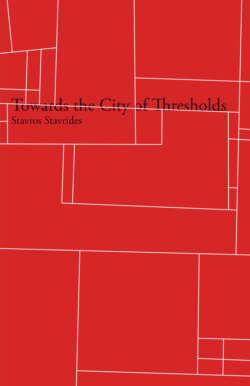Читать книгу Towards the City of Thresholds - Stavros Stavrides - Страница 14
На сайте Литреса книга снята с продажи.
An emancipating spatiality?
ОглавлениеThis book is divided into four parts that correspond to three interconnected areas of research concerning the threshold spatialities of emancipatory processes. The first part is organized around the idea that contemporary urban space is discontinuous: to understand spatiotemporal experiences we have to work with concepts that may capture this inherent discontinuity. Chapter 1 explains how in this context, rhythm and exception are appropriate terms if we aim at finding not only the characteristics but also the potentialities of the dominant urban model—that of a “city of enclaves.”
The second chapter of this section reveals that both rhythm and exception are not only the means to establish a dominant spatial order but also forms through which spatialities of resistance are created. Focusing on experiences of the aftermath, exile, and immigration, this chapter explores spatiotemporal discontinuity as a possible ground of encounter with otherness. Otherness, understood as a relative term, is shown to prosper in periods in which collective habits are destroyed or suspended.
The second part problematizes the encounter with otherness in the context of urban experience. Making use of Walter Benjamin’s unfinished study of nineteenth-century Paris, the opening chapter attempts to understand the metropolitan experience as inherently dynamic and ambiguous, containing both nightmarish elements and liberating potentialities. Through his description of the bourgeois private individual and the flâneur, two distinctive attitudes towards public and private space are exposed. Both attitudes are compared in terms of their dependence on the manipulation of individualizing traces in metropolitan life as well as their participation in the creation of (private or public) “auratic” urban phantasmagorias. A precarious “study of thresholds” is evoked, considered as a knowledge constructed through the ambiguous experience of the flâneur-as-allegorist. This study explores the dynamics of urban experience by pointing to the revealing trace-aura dialectics that permit the surfacing of a third, in-between element: the threshold. A “city of thresholds” thus describes the possibility of a “redeemed” urban modernity.
The next short chapter focuses on walking, considered as a practice that exposes the experience of otherness in the city, to further explore the spatiality of threshold. Porosity becomes a spatial quality, passages become spatial artifacts, and the act of crossing creates thresholds and activates threshold potentialities.
The following chapter presents one of the most critical points of the book’s argument: thresholds mark processes of transformations of social identity. Anthropology has theorized the difficult relationship between self and other as a culturally determined relationship. Approaching otherness (cultural as well as historical) is a crucial problem in social sciences and is equally so in the tactics of habitation. Having an appropriate distance of encounter is necessary for differences to persist without blocking negotiation and mutual understanding. The ability to recognize the appropriate distances in time and space critically influences the theatricality of social interaction. This ability is acquired and improved in the varied conditions of threshold creation. The in-between space of thresholds is explored in this chapter as a potential stage on which encountering otherness means visiting, rehearsing, testing, and exploring it.
The third part of the book brings together the findings of the two former parts to reveal the importance of threshold in understanding the spatial aspects of emancipating practices. The first chapter of the third part focuses on the threshold character of heterotopia. Reformulating Foucault’s definitions of heterotopia, we can consider all spatial experiences that “rehearse” a future of human emancipation as heterotopic. Beyond and against the city of enclaves, heterotopic spaces mark thresholds in space and time where dominant order and control are questioned.
Testing the idea of heterotopias, understood here as thresholds towards radical otherness, the remaining chapters analyze the words, actions, and practices of two exemplary cases where collective identities were put into crisis: the Zapatista rebellion and the December 2008 youth uprising in Athens. Both cases are instructive of how multiple and ambiguous collective experiences—heterotopic experiences—connect with threshold theatricality to produce heterotopic spaces inside and beyond dominant capitalist spaces. This is what a potential city of thresholds may look like.
The social experiments that take place in heterotopias essentially construct the thresholds of otherness that lead into the future. These thresholds, these heterotopias, are bound to the twists of social change. In them, the radical otherness of human emancipation is confronted, approached, and explored. Think of the Paris Commune of 1871, think of the settlements of the pobladores [squatters] in the Chile of Unidad Popular, think of the Lacandon Jungle as a Zapatista heterotopia, or, perhaps, think of the streets of Seattle, Genova, or Athens at the time of huge social protests. All of them are temporary thresholds, all of them are heterotopic gestures towards an emancipating otherness. The city of thresholds becomes the spatial equivalent of collectively inventing the future.
